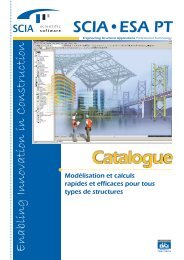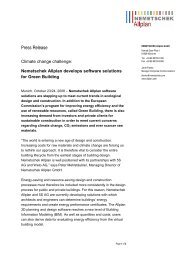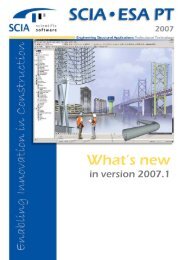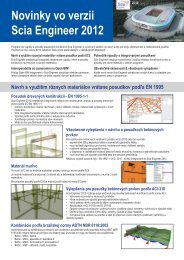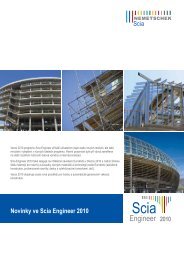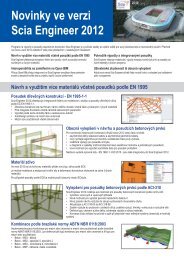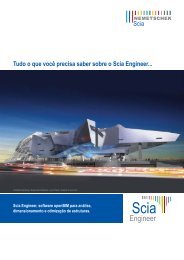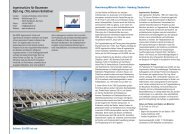VSH Turòa nad Bodvou - Nemetschek Scia
VSH Turòa nad Bodvou - Nemetschek Scia
VSH Turòa nad Bodvou - Nemetschek Scia
You also want an ePaper? Increase the reach of your titles
YUMPU automatically turns print PDFs into web optimized ePapers that Google loves.
Project: Bicyclist and pedestrian bridge “Het Domein”<br />
Type: Cable stayed mixed concrete-steel bridge<br />
Location: Houten (Utrecht), The Netherlands<br />
Construction firm: Welling<br />
Architect: Grontmij N.V.<br />
Engineering office: Ingenieursbureau STENDESS N.V., Lovendegem,<br />
Belgium<br />
Contractor: S3C/ Zuid Nederlandse constructie en apparatenbouw,<br />
Heyningen, The Netherlands<br />
Total steel weight: ± 65 tons<br />
Total length: 50 m<br />
Building period: 2005<br />
Short description of the project<br />
Because of the growing number of inhabitants, the village of<br />
Houten there was, the need to create new living areas. For this<br />
reason several suburbs were built in the form of leafs around the<br />
centre of Houten. These suburbs are separated by water. To guarantee<br />
an easy access between these suburbs a ‘bicycle and pedestrian<br />
bridge’ was needed.<br />
The bridge can be described as a cable stayed mixed concrete-steel<br />
bridge. Circular transverse beams connected to an asymmetrical<br />
pylon by cables support a mixed concrete-steel bridge deck. The<br />
bridge deck is curved.<br />
The asymmetrical pylon and the curved shape of the deck give, in<br />
combination with cables, a dynamic character to the bridge. The<br />
asymmetrical pylon represents the “gate” to the suburbs.<br />
Use of ESA-Prima Win<br />
Description of technical questions to be solved with<br />
ESA-Prima Win.<br />
Both for the dimensioning of the bridge in the traffic situation as<br />
well as for the erection engineering of the bridge, ESA-Prima Win<br />
was used.<br />
From the point of view of engineering this project was very challenging.<br />
First, there was the fact that the bridge deck was mixed<br />
concrete-steel. This implied a deck calculation in several stages with<br />
different stiffness factors and the calculation of cracked-uncracked<br />
concrete. The possibility of calculating mixed sections and the<br />
use of graphical sections by ESA-Prima Win was a big advantage.<br />
Secondly, there was the limitation of the reactions on the bridge<br />
end supports. Also here ESA-Prima Win proved its possibilities.<br />
Thirdly, there was the simulation of the realistic behaviour of the<br />
cables. The cables were simulated as classic bars, but with the Emodules<br />
of the tension bar material in relation to the inclination<br />
of the tension bars they were considered as cables with a fictive Emodulus.<br />
Because the linear calculations resulted in compression in<br />
the tension bars a non-linear calculation was needed. In the fourth<br />
place, it was necessary to perform a second order calculation for<br />
the check of asymmetrical pylons based on a stability calculation.<br />
Fifthly, for the erection engineering the different construction<br />
stages had to be examined and a severe erection manual for the<br />
mounting of the cables was needed. This was necessary to achieve<br />
the theoretical form of the bridge deck.<br />
And last but not least, the dynamic behaviour of the bridge had to<br />
be checked.<br />
Description of how our experience with ESA-Prima Win proved<br />
its completeness<br />
• Dimensioning a 3D structure consisting of different materials<br />
(steel, concrete)<br />
• The possibility of using and combining the results of ESA-Prima<br />
Win in a flexible way.<br />
• The possibility of calculating mixed concrete-steel sections.<br />
• The possibility of calculating graphical sections.<br />
• The possibility of using tension only elements for the modelling<br />
of the cables.<br />
• Stability calculation and second order calculations.<br />
• Checking the dynamic behaviour of the structure by calculating<br />
the ownvalues of the structure.<br />
This project proves the great diversity of ESA-Prima Win in checking<br />
the structure and the use of materials.<br />
Used modules:<br />
• Base<br />
• 3D frame<br />
• Dynamics<br />
• Steel code check (NEN)<br />
• Stability<br />
• Physical non linear conditions<br />
Bicyclist and pedestrian bridge<br />
Because of the growing number of inhabitants in the village<br />
of Houten there was the need to create new living areas.<br />
For this reason several suburbs were built in the form of leafs<br />
around the centre of Houten. These suburbs are separated<br />
by water. To guarantee an easy access between these<br />
suburbs a ‘bicycle and pedestrian bridge’ was needed.<br />
The bridge can be described as a cable stayed mixed<br />
concrete-steel bridge. Circular transverse beams connected<br />
to an asymmetrical pylon by cables support a mixed<br />
concrete-steel bridge deck. The bridge deck is curved.<br />
The asymmetrical pylon and the curved shape of the deck<br />
give, in combination with cables, a dynamic character to the<br />
bridge. The asymmetrical pylon represents the “gate” to the<br />
suburbs.<br />
Bicyclist and pedestrian bridge “Het Domein”<br />
101




